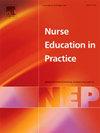Nurses’ learning about foot care for patients with diabetes: A rapid review
IF 4
3区 医学
Q1 NURSING
引用次数: 0
Abstract
Aim
To explore learning methods for nurses caring for patients with diabetes, focusing on foot care.
Background
Effective foot care is essential to prevent complications in patients with diabetes. While nurses play a key role in this care, many lack adequate knowledge and skills. Continuous professional development and targeted learning interventions are crucial for improving nurses’ knowledge.
Design
A rapid review was conducted to synthesize existing evidence on learning interventions for nurses in foot care for patients with diabetes.
Method
The literature search was performed in PubMed, CINAHL, MEDLINE and Academic Search Premier, which were selected for their broad coverage of nursing and medical research. The review followed Dobbins’ five-step model, which involves defining a practice question, systematically searching for evidence, critically appraising sources, synthesizing evidence and assessing applicability and transferability. Additionally, the PRISMA 2020 checklist was followed.
Results
Eight studies were included, highlighting learning to improve and contain knowledge through various learning interventions such as e-learning, workshops, problem-based learning and multidisciplinary consultations. The findings indicate that interactive and practical learning methods improve nurses’ knowledge and skills in foot care for patients with diabetes.
Conclusions
Practical and interactive learning methods are crucial for enhancing nurses’ knowledge in foot care for patients with diabetes. Continuous education and reflection are essential for long-term improvements in clinical practice. Future research should focus on the learning process itself to better understand how nurses internalize and apply new knowledge. Emphasizing theoretical and practical aspects of education can lead to more effective and sustainable learning outcomes.
护士对糖尿病患者足部护理的了解:快速回顾。
目的:探讨护理糖尿病患者的学习方法,以足部护理为重点。背景:有效的足部护理对预防糖尿病患者并发症至关重要。虽然护士在这方面发挥着关键作用,但许多护士缺乏足够的知识和技能。持续的专业发展和有针对性的学习干预是提高护士知识的关键。设计:对糖尿病患者足部护理中护士学习干预的现有证据进行快速回顾。方法:在PubMed、CINAHL、MEDLINE、Academic search Premier等数据库中选取涵盖护理和医学研究内容较广的文献进行检索。这篇综述遵循了Dobbins的五步模型,包括定义一个实践问题,系统地寻找证据,批判性地评估来源,综合证据和评估适用性和可转移性。此外,遵循PRISMA 2020检查表。结果:纳入了8项研究,强调了通过各种学习干预措施(如电子学习、研讨会、基于问题的学习和多学科咨询)提高和包含知识的学习。研究结果表明,互动式和实践性的学习方法提高了护士对糖尿病患者足部护理的知识和技能。结论:实用的互动式学习方法是提高护士糖尿病足部护理知识的关键。持续的教育和反思对于临床实践的长期改进是必不可少的。未来的研究应关注学习过程本身,以更好地了解护士如何内化和应用新知识。强调教育的理论和实践方面可以带来更有效和可持续的学习成果。
本文章由计算机程序翻译,如有差异,请以英文原文为准。
求助全文
约1分钟内获得全文
求助全文
来源期刊

Nurse Education in Practice
NURSING-
CiteScore
5.40
自引率
9.40%
发文量
180
审稿时长
51 days
期刊介绍:
Nurse Education in Practice enables lecturers and practitioners to both share and disseminate evidence that demonstrates the actual practice of education as it is experienced in the realities of their respective work environments. It is supportive of new authors and will be at the forefront in publishing individual and collaborative papers that demonstrate the link between education and practice.
 求助内容:
求助内容: 应助结果提醒方式:
应助结果提醒方式:


